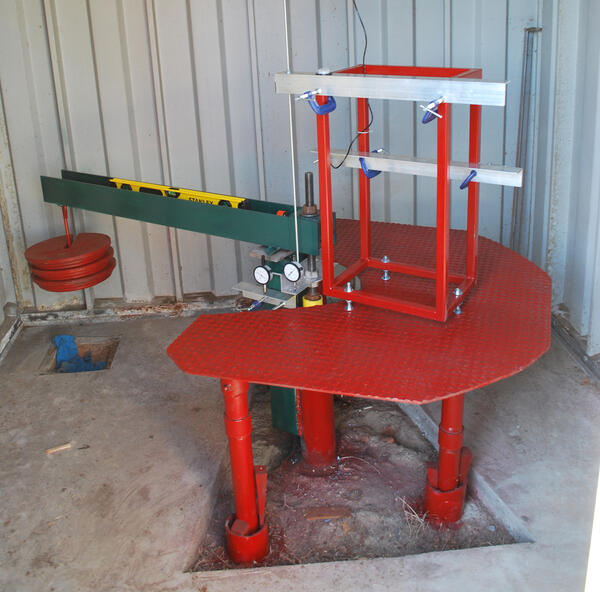Before and after imagery of the original Franklin Extensometer. The original Franklin extensometer measured aquifer compaction near the groundwater pumping center at Franklin, Virginia from 1979 to 1995.
Franklin Extensometer Historical Photo
Detailed Description
Image of the original extensometer at Franklin, Virginia, which recorded aquifer compaction from 1979 to 1995.
Originally published in:
Pope, J. P. (2002). Characterization and modeling of land subsidence due to groundwater withdrawals from the confined aquifers of the Virginia Coastal Plain (Doctoral dissertation, Virginia Tech).
Sources/Usage
Public Domain.
Pope, J. P. (2002). Characterization and modeling of land subsidence due to groundwater withdrawals from the confined aquifers of the Virginia Coastal Plain (Doctoral dissertation, Virginia Tech).
Related
The Virginia Extensometer Network
Land Subsidence on the Virginia Coastal Plain
Check out more images of our Franklin Extensometer research site below:
Before and after imagery of the original Franklin Extensometer. The original Franklin extensometer measured aquifer compaction near the groundwater pumping center at Franklin, Virginia from 1979 to 1995.

The USGS Franklin pipe extensometer with a total depth of 860 feet.
Period of record: 1979-1995; 2016-present
The USGS Franklin pipe extensometer with a total depth of 860 feet.
Period of record: 1979-1995; 2016-present
Building housing the USGS Franklin extensometer. Inside, the extensometer extends 866 feet below land surface.
Period of record: 1979-1995; 2016-present
Building housing the USGS Franklin extensometer. Inside, the extensometer extends 866 feet below land surface.
Period of record: 1979-1995; 2016-present

USGS Scientists inspect the Franklin Extensometer research site in 2015. The extensometer at Franklin had been measuring land subsidence since 1979 but had been offline since 1995 and would be brought back online the following year.
USGS Scientists inspect the Franklin Extensometer research site in 2015. The extensometer at Franklin had been measuring land subsidence since 1979 but had been offline since 1995 and would be brought back online the following year.
Photo of the original Franklin extensometer taken during an inspection in 2015. Recording had ended in 1995, and between 1995 and 2015, groundwater pumping rates lessened causing the aquifer to briefly recover and the land to rebound. This rebound was so significant that it caused the damage to the extensometer seen above.
Photo of the original Franklin extensometer taken during an inspection in 2015. Recording had ended in 1995, and between 1995 and 2015, groundwater pumping rates lessened causing the aquifer to briefly recover and the land to rebound. This rebound was so significant that it caused the damage to the extensometer seen above.
Under natural conditions, water levels in wells completed in many confined aquifers rise above the land surface, resulting in artesian flow. The well shown in the photograph was drilled near Franklin, Virginia, in 1941 to a depth of about 600 feet in confined aquifers. The initial water level in the well was about 7 feet above land surface.
Under natural conditions, water levels in wells completed in many confined aquifers rise above the land surface, resulting in artesian flow. The well shown in the photograph was drilled near Franklin, Virginia, in 1941 to a depth of about 600 feet in confined aquifers. The initial water level in the well was about 7 feet above land surface.
Related
The Virginia Extensometer Network
Land Subsidence on the Virginia Coastal Plain
Check out more images of our Franklin Extensometer research site below:
Before and after imagery of the original Franklin Extensometer. The original Franklin extensometer measured aquifer compaction near the groundwater pumping center at Franklin, Virginia from 1979 to 1995.
Before and after imagery of the original Franklin Extensometer. The original Franklin extensometer measured aquifer compaction near the groundwater pumping center at Franklin, Virginia from 1979 to 1995.

The USGS Franklin pipe extensometer with a total depth of 860 feet.
Period of record: 1979-1995; 2016-present
The USGS Franklin pipe extensometer with a total depth of 860 feet.
Period of record: 1979-1995; 2016-present
Building housing the USGS Franklin extensometer. Inside, the extensometer extends 866 feet below land surface.
Period of record: 1979-1995; 2016-present
Building housing the USGS Franklin extensometer. Inside, the extensometer extends 866 feet below land surface.
Period of record: 1979-1995; 2016-present

USGS Scientists inspect the Franklin Extensometer research site in 2015. The extensometer at Franklin had been measuring land subsidence since 1979 but had been offline since 1995 and would be brought back online the following year.
USGS Scientists inspect the Franklin Extensometer research site in 2015. The extensometer at Franklin had been measuring land subsidence since 1979 but had been offline since 1995 and would be brought back online the following year.
Photo of the original Franklin extensometer taken during an inspection in 2015. Recording had ended in 1995, and between 1995 and 2015, groundwater pumping rates lessened causing the aquifer to briefly recover and the land to rebound. This rebound was so significant that it caused the damage to the extensometer seen above.
Photo of the original Franklin extensometer taken during an inspection in 2015. Recording had ended in 1995, and between 1995 and 2015, groundwater pumping rates lessened causing the aquifer to briefly recover and the land to rebound. This rebound was so significant that it caused the damage to the extensometer seen above.
Under natural conditions, water levels in wells completed in many confined aquifers rise above the land surface, resulting in artesian flow. The well shown in the photograph was drilled near Franklin, Virginia, in 1941 to a depth of about 600 feet in confined aquifers. The initial water level in the well was about 7 feet above land surface.
Under natural conditions, water levels in wells completed in many confined aquifers rise above the land surface, resulting in artesian flow. The well shown in the photograph was drilled near Franklin, Virginia, in 1941 to a depth of about 600 feet in confined aquifers. The initial water level in the well was about 7 feet above land surface.








